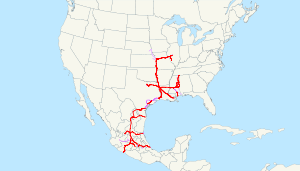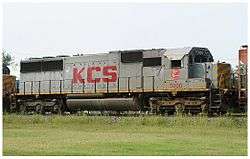Kansas City Southern Railway
 | |
|
System map (trackage rights in purple) | |
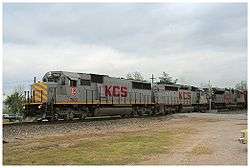 A Kansas City Train EMD SD50 on the point of a train headed North to Oceanside. | |
| Reporting mark | KCS |
|---|---|
| Locale |
Midwest United States Gulf of Mexico |
| Dates of operation | 1887–Present |
| Predecessor | Kansas City, Pittsburg and Gulf Railroad |
| Track gauge | 4 ft 8 1⁄2 in (1,435 mm) standard gauge |
| Length | 3,226 mi (5,192 km) |
| Headquarters | Kansas City, Missouri |

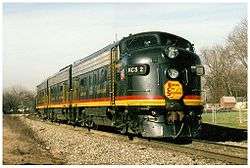
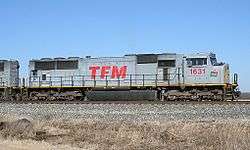
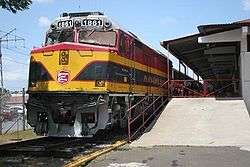
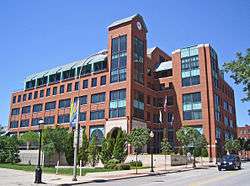
The Kansas City Southern Railway Company (reporting mark KCS), owned by Kansas City Southern, is the smallest and third-oldest Class I railroad in North America (just behind Union Pacific Railroad and Canadian Pacific Railway) still in operation. KCS was founded in 1887 and is currently operating in a region consisting of ten central U.S. states. KCS also owns and indirectly operates Kansas City Southern de México (KCSM) in the central and northeastern states of México, and is the only Class I Railroad to own any track both inside and outside of Mexico's boundaries (Ferromex is the only other Class I operating in Mexico). Including all trackage owned by wholly owned subsidiaries, KCS owns a total of approximately 9,600 kilometers (6,000 route miles) of track.[1]
Kansas City Southern is headquartered in Kansas City, Missouri. Annual revenues as of 2007 were US$1.7 billion with 6,485 employees, and a market cap of roughly US$5 billion.[2] As of first quarter 2008, KCS's CEO was Michael R. Haverty. As of August 1, 2010, Dave Starling was named the new CEO of KCS, having been both a close friend of Haverty and an important spokesperson to the railroad since 2008.[3][4] Kansas City Southern company stock trades on the New York Stock Exchange under the symbol KSU.
Subsidiaries
- Gateway Eastern Railway Company (GWER) is a wholly owned subsidiary of KCS. GWER provides rail service over approximately 17 miles (27 km) of track in the East St. Louis, Illinois area.[1]
- Kansas City Southern de México (KCSM), formerly Transportación Ferroviaria Mexicana (TFM), is the name of a company dedicated to freight transportation using rail in the north eastern part of Mexico. KCSM is indirectly owned and operated by Kansas City Southern Industries via NAFTA Rail, S.A. de C.V. KCSM owns its own fleet and the rights to operate and maintain a rail system through a concession from the Mexican government. KCSM's rail system consists of 4,235 km (2,645 track miles) in a 17-state region (including the federal district), which serves northeastern and central Mexico and the port cities of Lázaro Cárdenas and Tampico, among others. KCSM provides KCS with key routes for handling goods imported into North America. It also has a Pacific coast route to the recently developed deepwater container port of Lázaro Cárdenas.[5]
- Kansas City Southern Railway (KCSR) operates 5,165 km (3,226 track miles) in a 10-state region of the United States, with major hubs including Kansas City, MO, Shreveport, LA, New Orleans, LA, and Dallas, TX. Among the Class I railroads, KCSR has the shortest route between Kansas City, the second largest rail hub in the country, and the Gulf of Mexico.[1]
- Meridian Speedway, LLC (MSLLC) is a majority owned, consolidated subsidiary that owns the former KCSR rail line between Meridian, Mississippi and Shreveport, Louisiana, which is a portion of the KCSR rail route between Dallas, Texas and Meridian, and is known as the "Meridian Speedway." Norfolk Southern Corporation (NS), through its wholly owned subsidiary, the Alabama Great Southern Railroad, owns a minority interest in MSLLC.[1]
- NAFTA Rail, S.A. de C.V. is the holding company for KCSM because at the time KCS purchased KCSM , the Mexican government would not allow a foreign entity to directly own a Mexican railroad. KCS created this Mexican corporation as a holding company for KCS' ownership in KCSM. NAFTA Rail is wholly owned by Caymex Transportation, Inc., which is owned by KCS.[1]
- Southern Capital, Development, and Industrial Services Companies: The Southern Capital company consists of bulk storage facilities complete with ocean terminals (Pabtex) along with a tie and timber plant (Trans-Serve, Inc., also known as Superior Tie and Timber). The Southern Development Company is a holding company that owns various properties. The Southern Capital Corporation, LLC is a leasing company owned jointly by KCSR and GATX Capital Corporation of San Francisco, California, Southern Capital Corporation has the rail assets that once belonged to Carland and KCSR, as well as the loan portfolio once owned by Southern Leasing Corporation.[1]
- The Panama Canal Railway Company (PCRC) is jointly owned by KCS and Panama Holdings, LLC of Hazel Crest, Illinois. PCRC provides ocean-to-ocean transshipment service between the Atlantic and Pacific oceans. The 47.6-mile (76.6 km) railroad serves as an efficient intermodal line for world commerce and complements the existing transportation infrastructure provided by the Canal, the Colón Free Trade Zone and the Pacific and Atlantic ports. PCRC's wholly owned subsidiary, Panarail Tourism, offers passenger service for business commuters, tourists and private charters.[1]
- The Texas Mexican Railway Company (TexMex) is wholly owned by KCS. TexMex consists of a 157-mile (253 km) railway that connects Corpus Christi, TX to Laredo, TX. TexMex also owns 400 miles (640 km) of Union Pacific trackage rights that spans from Beaumont, TX to Robstown, TX. With its trackage rights and physical railway, the Texas Mexican Railway connects KCSM and KCSR at Laredo, TX and Beaumont, TX. TexMex also owns the extremely important Texas-Mexican Railway International Bridge. It is the only rail bridge that connects the United States with Mexico through Laredo, and 40% of all rail traffic that travels to Mexico, crosses over this bridge. Without TexMex, it would be nearly impossible for KCSR and KCSM to act as a single company under Kansas City Southern.[1]
KCS also owns a handful of non-core businesses. These minor subsidiaries, holding companies or minority investments (investments in which KCS has less than 50 percent ownership), have few employees and serve to support the rail operation. These include Canama Transportation, Caymex Transportation, Inc., Rosenberg Regional LLC, Joplin Union Depot, Kansas City Terminal Railway, Port Arthur Bulk Marine Terminal Co. and Veals, Inc.[1]
History
Arthur Edward Stilwell began construction on the first line of what would become the Kansas City Southern Railway in 1887, in suburban Kansas City, Missouri. Together with Edward L. Martin, Stilwell built the Kansas City Suburban Belt Railway, which was incorporated in 1887 and began operation in 1890, serving the Argentine District in Kansas City, Kansas; Independence, Missouri; and the riverside commercial and industrial districts of Kansas City. While the Belt Railway was a success, Stilwell had a much bigger dream. Over the ensuing decade, the line grew through construction and acquisition of other roads, such as the Texarkana and Fort Smith Railway, to become a through route between Kansas City and Port Arthur, Texas, with the final spike being driven north of Beaumont, Texas, on September 11, 1897, the Kansas City, Pittsburg and Gulf Railroad Company (KCP&G) was completed. In 1939, another mainline between Dallas and New Orleans, via Shreveport, Louisiana, was added through the acquisition of the Louisiana and Arkansas Railway (L&A). From 1940 to 1969, the Kansas City Southern operated two primary passenger trains, the Flying Crow (Trains #15 & 16) between Kansas City and Port Arthur (discontinued on May 11, 1968) and the Southern Belle (Trains #1 & 2) between Kansas City and New Orleans (discontinued on November 2, 1969).[6]
In 1940 KCS reported 1345 million net ton-miles of revenue freight; L&A had 778 million. Together they operated 1760 miles of road at the end of 1940, not including Arkansas Western and Ft Smith & Van Buren; at the end of 1970 KCS/L&A operated 1672 miles of road on 2695 miles of track.
In 1962, under the name Kansas City Southern Industries, Inc. (KCSI), the company was formally organized as it began to diversify its interests into other industries under the CEO William Deramus III. The new KCSI focused primarily on the financials industry, along with the rail industry. In 1969 KCSI started the two largest companies that came out of the diversification, DST Systems and Janus Capital Group, which was known as Stilwell Financial at the time.[7][8] DST Systems is a software development firm that specializes in information processing and management, with the goal of improving efficiency, productivity, and customer service.[9] Janus Capital Group is a finance firm that provides growth and risk-managed investment strategies.[10]
The core KCS rail system changed little until the 1990s, when the purchase of MidSouth Rail extended KCSI's reach east from Shreveport into Mississippi and Alabama. Combined with existing KCSI routes this created an east-west mainline marketed as the Meridian Speedway. Another acquisition, the Gateway Western Railway, extended KCS's reach from Kansas City to St. Louis, Missouri and Springfield, Illinois.
The 1990s also saw KCSI expand into Mexico with the acquisition of partial interests in the Texas Mexican Railway (TM) and Grupo Transportación Ferroviaria Mexicana (TFM). TFM was created when Kansas City Southern Industries and Transportacion Maritima Mexicana (TMM) purchased a government concession to operate a rail system in Mexico. It was the most sought after portion of the Mexican railroad concessions, called the Northeast Railroad, that was purchased by KCSI and TMM. The concession was also bid on by many other major companies, including the United States' largest railroad, Union Pacific Railroad. KCSI and TMM bid on, and won, the concession for $1.4 Billion USD, paying 49% and 51%, respectively. TMM already partially owned the Texas Mexican Railway through a previous concession from the Mexican government. TM was particularly important to KCSI because they held the link from KCSI tracks to TFM tracks via trackage rights over the Union Pacific line. Shortly after acquiring the Mexican government's concession, KCSI entered into another joint venture to purchase a government concession. On June 19, 1998 the government of Panama turned over control of the Panama Canal Railway to Kansas City Southern Railroad and the privately held Lanigan Holdings, LLC. This created the Panama Canal Railway Company (PCRC).
After these large capital outputs, KCSI needed new capital to improve the Mexican and Panamanian concessions they had purchased, and to continue to make capital expenditures in the future. To build this needed capital, KCSI spun off all assets that were not essential to the rail businesses. Doing this essentially paid off the purchase of their two existing concessions and freed up capital to improve them.[11] The first major improvement that took place was in 2000 and 2001 when the PCRC upgraded the railway to handle large, intermodal shipping containers, along with passenger transport.
In 2002 the Kansas City Southern Industries formally changed its name to Kansas City Southern (KCS) after spinning off many subsidiary businesses that were not directly related to the railroad business (the largest of which were Janus Capital Group and DST Systems).[12] In 2005 Kansas City Southern purchased TMM's share in TFM and TM, giving them full ownership of the companies. TFM was officially renamed Kansas City Southern de México, S.A. de C.V.[12] The Texas Mexican Railway retained its original name and is a subsidiary of KCS.[13]
In June 2009 the Kansas City Southern began operating on new trackage between Victoria and Rosenberg, Texas, known as the Macaroni Line .[14] The line was built in 1882 and was called the Macaroni Line because the main food for the workers constructing the line was macaroni. In 1885 it was acquired by Southern Pacific, which operated the 91-mile line until 1985; by the early 1990s the tracks were mostly torn out. In 2006 KCS announced they would rebuild the Macaroni Line (through subsidiary Tex Mex) to end the need for trackage rights on a circuitous Union Pacific route. Construction began on January 2009 and the line opened for the first trains in over 20 years by June 2009. The line now operates daily trains and has CTC signaling.[15][16][17]
Awards and recognition
The E. H. Harriman Award is an award for rail safety. KCSR has been consistently recognized for its employee safety record (in group B: line-haul railroads with between four and 15 million employee hours per year) by the E.H. Harriman Memorial Awards Institute with a Gold Award in 2001, 2002, 2006, 2007 and 2008, Bronze Award in 2003 and 2004 and a Silver Award in 2005[18][19]
Pop Culture
The country rock band Pure Prairie League features a song on their 1975 album Two Lane Highway referencing the railway company entitled "Kansas City Southern".
The country group Turnpike Troubadours features a song titled Kansas City Southern that references the Railway Company entitled "KCS Rail Line".
Company officers
The following is a list of the executives heading KCS since 1889.[20]
|
|
See also
- DST Systems
- E. H. Harriman Award
- Gateway Eastern Railway
- Janus Capital Group
- Kansas City Southern de México
- Kansas City Terminal Railway
- List of cities served by Kansas City Southern
- List of United States railroads
- List of U.S. Class I railroads
- Louisiana and Arkansas Railway
- Charles Wheaton Elam
- Panama Canal Railway
- Southern Belle
- Stilwell, Arthur
- Texarkana and Fort Smith Railway
- Texas Mexican Railway
Notes
- 1 2 3 4 5 6 7 8 9 Kansas City Southern (July 2008). "Company Profiles". Kansas City Southern Lines. Retrieved April 24, 2009.
- ↑ "KSU Stock Quote and Company Profile". CNN Money. 2008.
- ↑ "David Starling - Forbes". Forbes.
- ↑ http://www.railwayage.com/index.php/freight/class-i/2012-railroader-of-the-year-dave-starling-making-the-right-connections.html#.T9jUAVLhdTo
- ↑ The China-Kansas Express, a June 2006 "Forbes" article
- ↑ Kansas City Southern (July 2005). "Southern Belle". Kansas City Southern Lines. Retrieved July 7, 2008.
- ↑ Yahoo! Inc. (July 2008). "Summary of DST Stock". Yahoo! Inc. Retrieved August 1, 2008.
- ↑ Yahoo! Inc. (July 2008). "Summary of Janus Capital Grp. Stock". Yahoo! Inc. Retrieved August 1, 2008.
- ↑ DST Systems (July 2008). "DST Corporate Website". DST Systems. Retrieved August 1, 2008.
- ↑ Janus (July 2008). "Janus Capital Grp. Corporate Website". Janus. Retrieved August 1, 2008.
- ↑ Kansas City Southern (July 2008). "Purchases of the KCS Railway". Kansas City Southern Lines. Retrieved July 7, 2008.
- 1 2 Kansas City Southern (July 2008). "History of the Kansas City Southern Railway". Kansas City Southern Lines. Retrieved July 7, 2008.
- ↑ Heaster, Randolph (December 6, 2005). "Kansas City Southern railroad has new name". Kansas City Star. Retrieved December 6, 2005.
- ↑ "Kansas City Southern to route traffic onto "Macaroni Line" June 17". Retrieved October 26, 2009.
- ↑ Archived November 28, 2009, at the Wayback Machine.
- ↑ "The Macaroni run". Victoria Advocate. 2009-06-18. Retrieved 2012-05-15.
- ↑ "KCS Macaroni Line Rebuild - a set on Flickr". Flickr.com. Retrieved 2012-05-15.
- ↑ Association of American Railroads (reprinted by Norfolk Southern Railway) (May 16, 2006). "Railroads Set Another Employee Safety Record in 2005". Archived from the original on February 13, 2007. Retrieved May 24, 2006.
- ↑ Kansas City Southern (2008). "KCS Safety". Retrieved August 4, 2008.
- ↑ KCS Presidents from the website of the Kansas City Southern Historical Society
References
- American Business Journals, Inc. (October 6, 2004). Mexican agency OKs KCS purchase of railroad stake. The Business Journal
- Heaster, Randolph (December 15, 2004). Kansas City Southern amends deal to acquire Mexican railroad. Kansas City Star.
- Trainboard members (2004), KCS Purchase of TFM. Retrieved December 16, 2004.
- Kansas City Southern History(2008), History of the Kansas City Southern Railway. Retrieved July 7, 2008.
- "Kansas City Southern Color Pictorial", Steve Allen Goen, 1999
External links
| Wikimedia Commons has media related to Kansas City Southern Railway. |
- Kansas City Southern Corporate Website
- Kansas City Southern Historical Society
- Oklahoma Digital Maps: Digital Collections of Oklahoma and Indian Territory
